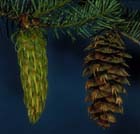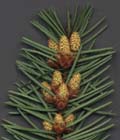
The Queets fir, for 50 years one of the largest known Douglas-firs [C.J. Earle].

Immature and mature cones [Dr. Linda B. Brubaker].

Closeup of the underside of a sun foliage shoot, showing pollen cone buds and the manner of leaf attachment to the twig [C.J. Earle].

Active pollen cones on a shoot [C.J. Earle].
Common Names
Coast Douglas-fir, Douglas-fir (3).Taxonomic notes
Description
Trees to 90(100) m; trunk to 440 cm diam. Leaves yellowish green. Seed cones 6-10 cm; bracts straight, appressed. 2n=26 (3).Range
Canada: British Columbia; USA: Washington, Oregon, Nevada, California; at 0-1800 m in conifer or mixed forests (3)."Nearly pure stands of Douglas-fir continue south from their northern limit on Vancouver Island through western Washington, Oregon, and the Klamath and Coast Ranges of northern California as far as the Santa Cruz Mountains. In the Sierra Nevada, Douglas-fir is a common part of the mixed conifer forest as far south as the Yosemite region
Climate
Douglas-fir grows under a wide variety of climatic conditions, as shown in the following Table. "The coastal region of the Pacific Northwest has a maritime climate characterized by mild, wet winters and cool, relatively dry summers, a long frost-free season, and narrow diurnal fluctuations of temperature (6° - 8° C; 43° - 46° F). Precipitation, mostly as rain, is concentrated in the winter months. Climate in the Cascade Range and Sierra Nevada tends to be more severe" (4).
Table 1óClimatic data for [two] regional subdivisions of the range of [Coast] Douglas-fir (Baldwin 1973, U.S. Department of Commerce 1957).
| Region | Mean temperature | Frost-free period | Mean precipitation | ||
|---|---|---|---|---|---|
| July | January | Annual | Snow fall | ||
| °C | °C | days | mm | cm | |
| Pacific Northwest Coastal | 20 to 21 | 2 to 3 | 195 to 260 | 760 to 3400 | 0 to 60 |
| Cascades and Sierra Nevada | 22 to 30 | -9 to 3 | 80 to 180 | 610 to 3050 | 10 to 300 |
Table quoted verbatim from: Burns & Honkala 1990.
"Altitude has a significant effect on local climate. In general, temperature decreases and precipitation increases with increasing elevation on both western and eastern slopes of the mountains. Winters are colder, frost-free seasons are shorter, and diurnal fluctuations of temperature are larger (10° to 16° C; 50° to 61° F). Much of the precipitation is snow" (4).
Soils and Topography
"The variety menziesii of Douglas-fir reaches its best growth on well-aerated, deep soils with a pH range from 5 to 6. It will not thrive on poorly drained or compacted soils. Soils in the coastal belt of northern California, Oregon, and Washington originated chiefly from marine sandstones and shales with scattered igneous intrusions. These rocks have weathered deeply to fine-textured, well-drained soils under the mild, humid climate of the coast. Surface soils are generally acid, high in organic matter and total nitrogen, and low in base saturation. Soils in the Puget Sound area and in southwestern British Columbia are almost entirely of glacial origin. Soils farther inland within the range of the variety menziesii are derived from a wide variety of parent materials. These include metamorphosed sedimentary material in the northern Cascades and igneous rocks and formations of volcanic origin in the southern Cascades.
"Depth of soils ranges from very shallow on steep slopes and ridgetops to deep in deposits of volcanic origin and residual and colluvial materials. Texture varies from gravelly sands to clays. Surface soils are in general moderately acid. Their organic matter content varies from moderate in the Cascade Range to high in portions of the Coast Range and Olympic Peninsula. Total nitrogen content varies considerably but is usually low in soils of glacial origin. Great soil groups characteristic of the range of coastal Douglas-fir include Haplohumults (Reddish Brown Lateritics) of the order Ultisols, Dystrochrepts (Brown Lateritics), Haplumbrepts (Sols Bruns Acides) of the order Inceptisols, Haplorthods (Western Brown Forest soils) of the order Spodosols, Xerumhrepts (Brown Podzolic soils), and Vitrandepts (Regosols) (Washington State University 1979).
"Altitudinal limit for Douglas-fir in central British Columbia is about 760 m (2,500 ft) but rises to 1250 m (4,100 ft) on Vancouver Island. In Washington and Oregon, the species generally occurs from sea level to 1520 m (5,000 ft), although locally it may occur higher. In the southern Oregon Cascades and in the Sierra Nevada, the altitudinal range is between 610 and 1830 m (2,000 and 6,000 ft). In river valleys and canyon bottoms, the species may occasionally occur at elevations of 240 to 270 m (800 to 900 ft). Near the southern limit of its range in the Sierra Nevada, the species grows to elevations of 2300 m (7,500 ft)" (4).
Associated Forest Cover
"Periodic recurrence of catastrophic wildfires created vast, almost pure stands of coastal Douglas-fir throughout its range north of the Umpqua River in Oregon. Although logging has mainly eliminated the original old-growth forest, clearcutting combined with slash burning has helped maintain Douglas-fir as the major component in second-growth stands. Where regeneration of Douglas-fir was only partially successful or failed, red alder (Alnus rubra) has become an associate of Douglas-fir or has replaced it altogether.
"Douglas-fir yields to ponderosa pine (P. ponderosa), incense-cedar (Libocedrus decurrens), Oregon white oak (Quercus garryana), California black oak (Q. kelloggii), canyon live oak (Q. chrysolepis), and interior live oak (Q. wislizeni) on droughty sites, and to western redcedar (Thuja plicata), maples (Acer spp.), red alder, black cottonwood (Populus trichocarpa), and other broad-leaved species on poorly drained sites.
"Toward the fog belt of the Pacific coast, Douglas-fir gives way to Sitka spruce (Picea sitchensis), western hemlock (Tsuga heterophylla), and western redcedar.
"Wherever Douglas-fir grows in mixture with other species, the proportion may vary greatly, depending on aspect, elevation, kind of soil, and the past history of an area, especially as it relates to fire. ...
"The most important shrubs associated with coastal Douglas-fir (Franklin and Duyrness 1973) through its central and northern range are vine maple (Acer circinatum), salal (Gaultheria shallon), Pacific rhododendron (Rhododendron macrophyllum), Oregon grape (Berberis nervosa), red huckleberry (Vaccinium parvifolium), and salmonberry (Rubus spectabilis). Toward the drier southern end of its range, common shrub associates are California hazel (Corylus cornuta var. californica), oceanspray (Holodiscus discolor), creeping snowberry (Symphoricarpos mollis), western poison-oak (Toxicodendron diversilobum), ceanothus (Ceanothus spp.), and manzanita (Arctostaphylos spp.)" (4).
Big Tree
The largest volume tree is the Red Creek Fir, about 18 km by road from Port Renfrew on Vancouver Island, British Columbia. The tree is widely known and directions for locating it are available in Port Renfrew. In 1985 it was measured as having a height of 74 m, dbh of 402 cm, and crown spread of 22.9 m (1). I recently (December 1998) visited this tree with Dr. Robert Van Pelt and will shortly post remeasurement data, including wood volume, collected during that visit. This tree is the largest known individual in the family Pinaceae. Other exceptional specimens include:Measured March 1998, a tree near Lake Quinault in Olympic National Forest, WA. Its height is 86.0 m, dbh 409 cm, crown spread 25.9 m, and wood volume 308 cubic meters (8). The precise location has not been released, but this is a fine area to see enormous trees in general (e.g., the largest Picea sitchensis in the U.S. is nearby).
The Brummit Fir: Height 100.3 m, dbh 354 cm, on E. Fork Brummit Creek in Coos County, Oregon (2). This is the tallest known tree in the family Pinaceae, and is the only one known to exceed 100 m in height; the only other species known to contain living individuals more than 100 metres tall is Sequoia sempervirens.
The Queets Fir: Height 62.5 m, dbh 441 cm, in the Queets River valley of Olympic National Park, WA (6). This tree has been known for about 50 years and for most of that time was regarded as the largest known Douglas-fir (although the Brummit Fir also held that title for about 15 years). It has grown slightly smaller over time due to the loss of its top and large branches and now all live foliage is restricted to a single very large branch. This tree is also widely known and easily reached by trail; directions are available from Olympic National Park ranger stations.
Oldest
A ring-counted age(?) of 1350 for a specimen from Vancouver Island (BC) collected by M.L. Parker and Les Jozsa (5). This tree was one member of stand that established after a fire ca. 635 A.D. It blew down in a storm in the winter of 1985-86, providing an opportunity to date it (1). It is plausible that older trees are still alive in the stand. There is also a record of a 1307 years for a stump in a clearcut on Waterloo Mtn, Vancouver Island, sampled by Les Jozsa (10).Dendrochronology
Numerous collections have been made to study topics as diverse as stand age structure, stand dynamics, air pollution impacts on tree growth, and climate change.Ethnobotany
This was the preferred species for Hawaiian war canoes. The Hawaiians, of course, did not log the trees; they had to rely on driftwood. It was also used by the Hawaiians and other Polynesian for bowls, paddles, and sundry other implements.Within its home range, native peoples preferred it for fuel and also used its wood for diverse implements, including harpoon shafts and barbs, spoons and caskets. Its pitch was used for sealing joints and as a caulk for canoes and water vessels, and was also used as a medicinal salve for wounds (9).
Much of the Pacific Northwest was settled primarily for the purpose of logging vast forests of giant Douglas-fir trees, which dominated portions of the landscape, such as the western Cascade Range, prone to severe but infrequent wildfire. At that time it was used primarily for construction, and many of the older houses in western Washington contain no other wood except for cedar (Thuja plicata) siding and shingles. It continues to be the preferred timber species in the region.
Observations
The largest trees and most impressive forests are found in northwest North America, within 200 km of the Pacific Ocean. These are of var. menziesii. Some of the most spectacular stands are to be found in Olympic National Park and Mt. Rainier National Park (WA), but scores if not hundreds of extraordinary stands are still to be found in CA, OR, WA and BC. Nearly all of these are montane stands. Far larger trees, some as large as the largest living redwoods, were once widespread at low elevations on Vancouver Island and throughout the Puget-Willamette Trough, but virtually all have been logged. Remnant low-elevation stands can still be found in Deception Pass State Park (WA), Lighthouse Park (near Vancouver, BC), in the Port Renfrew area and probably other areas on Vancouver Island.Remarks
Citations
(1) Stoltmann 1987.(2) E-mail communication from Robert Van Pelt, 21-Apr-1998.
(3) B. Lipscomb at the Flora of North America web site.
(4) R.K. Hermann & D.P. Lavender, p. 527-540 in Burns & Honkala 1990.
(5) Brown 1996.
(6) E-mail communication from Robert Van Pelt, who measured the big trees; 18-Mar-1998.
(7) Hickman 1993.
(8) E-mail communication from Robert Van Pelt, who measured this tree; 30-Mar-1998.
(9) Pojar & Mackinnon 1994.
(10) R. Stoltmann. 1993. Guide to record trees of British Columbia. Vancouver: Western Canada Wilderness Committee. 58pp.
See also FEIS database.
back | Pseudotsuga | Pinaceae | home
This page is from the Gymnosperm Database
URL: http://www.geocities.com/~earlecj/pi/ps/menziesii2.htm
Edited by Christopher J. Earle
E-mail:earlecj@earthlink.com
Last modified on 24-Oct-1999